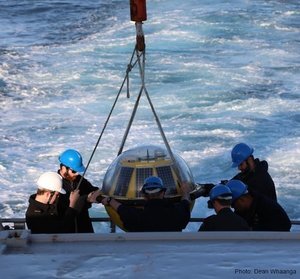Southern Ocean Research
MetOcean Solutions currently has six instruments collecting wave data in the Southern Ocean, including one moored and five drifting buoys. Here we provide graphs showing the real-time data. Note all these data are freely available to the scientific community.
Use your mouse to scroll, pan and inspect individual data records, and to navigate on the map.
Click on the following terms for explanations of significant wave height, maximum wave height and peak wave period.
Moored wave buoys
1st deployment
Type: TRIAXYS™ directional wave buoy
Date of deployment: 8 February 2017
Moored until: 28 July 2017 (currently drifting)
Maximum wave height measured: 19.4m on 20 May 2017
Vessel: HMNZS OTAGO
2nd deployment
Type: TRIAXYS™ directional wave buoy
Date of deployment: 2 March 2018
Moored until: 6 June 2019
Maximum wave height measured: 23.8m on 09 May 2018
Vessel: HMNZS WELLINGTON
3rd deployment
Type: TRIAXYS™ directional wave buoy
Date of deployment: 23 November 2018
Moored until: present
Vessel: HMNZS CANTERBURY
Drifting wave buoys
Type: Spoondrift Spotter
Date of release: 14 February 2018
Vessel: RV TANGAROA
In partnership with Spoondrift and Defence Technology Agency, this deep south program is a trial of some new wave buoy technology. The Spotter wave buoys have had extensive testing in coastal environments, but their response in energetic open ocean states is unknown. If effective however, they could revolutionise the way we monitor the remote ocean basins through a constellation of drifting buoys.
The names of these drifting buoys are inspired by five waka navigators who voyaged from Rangiatea to Aotearoa New Zealand in ancient times, searching for peace and prosperity.
Turi captain of the waka Aotea
Ruatea captain of the waka Kurahaupo
Ngahue captain of the waka Tāwhirirangi
Kiwa captain of the waka Horouta
Hoturoa captain of the waka Tainui
More about the intrepid polynesian navigators...
Turi captain of the Aotea waka
Rongorongo, Turi’s wife, asked her father to provide them with a waka, so he created Aotea from the second half of a great tree. The first half was used for the waka Matahorua that was captained by Kupe. When the time came for Turi to leave Rangiatea on the voyage, Kupe said to him “Keep your steering eastwards, where the sun rises keep the bow of your canoe ever steadily oriented towards that point of the sky." Arriving in Aotea Harbour, Turi and his fellow voyagers travelled down the West Coast naming places as they went; Kawhia, Mokau, Waitara, Oakura, Kaupokonui, Kapuni and Patea. They finally settled in Patea.
Ruatea captain of the Kurahaupo waka
The Kurahaupo waka voyaged from Rarotonga to Aotearoa New Zealand, but was badly damaged off Rangitahuahua (Raoul Island in the Kermadec Sanctuary). Many on board transferred to the Aotea waka including Ruateas younger brother Taumauriorongo. Ruatea and his remaining crew repaired the waka and continued on their voyage, passing Te Tai Rawhiti (the East Coast) and through Raukawa Moana (Cook Strait) to come finally land in the Rangitikei region where Ruatea and his crew disembarked.
Ngahue captain of the Tāwhirirangi waka
Legend has it that the Tāwhirirangi waka travelled alongside Kupe in the Matahorua waka in pursuit of Whekenui - a large octopus that had been taking the fish and bait from Kupe and his people. Tāwhirirangi voyaged across Te Moana nui-a-Kiwa (The Great Ocean of Kiwa) and landed first at Te Moana-a-Toi (Bay of Plenty). Continuing their pursuit, Ngahue managed to corner Te Wheke the octopus at Rangiwhakaoma (Castlepoint), but the great octopus managed to escape. The two crews continued to pursue Te Wheke until it was slain by Kupe in a heroic battle at Nga Whatu (The Brothers Island). From here the two waka continued their expedition and sailed down the western side of Te Wai Ponamu (The South Island).
Kiwa captain of the Takitimu waka and divine guardian of the sea
There are two recorded stories of Kiwa - one as an atua (God) and the other tangata (man). Guardians of the ocean were appointed to control its bounds and currents; Kiwa was one of these amongst a group who were regulators and controllers of the ocean. Kiwa was the offspring of the Potuangahuru - the tenth period of Chaos, and his wife was Hinemoana - the maid who was the ocean personified.
Another Kiwa recorded in oral history was Kiwa the captain of the Takitimu waka - a sacred canoe that voyaged to Aotearoa New Zealand followed by the Horouta waka - captained by Paoa. Takitimu arrived at Turanganui-a-Kiwa (Poverty Bay in Gisbourne) which translates to “the long waiting place of Kiwa” due to Kiwa’s wait for the Hourouta waka to arrive after him.
Hoturoa high priest and captain of the Tainui waka
Ko Tainui te waka; Ko Hoturoa te tangata! (Tainui is the canoe; Hoturoa is the man!) Hoturoa led his people away from tribal skirmishes that preceded migration from Rangiatea to Aotearoa, but when he learned that Turi and others intended to leave Rangiatea, Hoturoa decided to follow them. Tainui first landed at Whangaparoa and from there explored the coast northwards and sailed into Waitemata Harbour. He then proceeded on to Manukau harbour and inland regions.
Some of the Tainui people settled in Whaingaroa (Raglan), Kawhia and Mokau. The last party left on board - the Ngati Tara - beached at Te Waiiti and Tainui. When hearing of this, Hoturoa who had settled at Kawhia was unhappy with the fate of the Tainui. So he gathered a party and travelled down to refloat the waka, where he sailed it to Kawhia. The Tainui was then drawn up into a manuka grove below the shrine of Ahurei, and two stone pillars, set at either end, mark where it rested. These limestone pillars still stand to this day - over 26 metres apart, at the Maketu Marae in Kawhia. The anchor used for the Tainui is also still present in Mokau and can be visited at the Awakino rivermouth.









